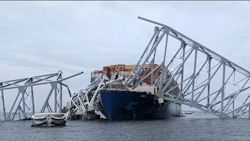Supply Chain Implications of Baltimore Bridge Collapse
Shipping traffic to and from the Port of Baltimore has been suspended following the Dali container ship’s collision into the Francis Scott Key Bridge on March 26, which caused the bridge to collapse. With search and rescue efforts underway alongside authorities cleaning up the accident site and mitigating environmental damage from potential oil spills, and investigations into the incident which are about to begin, it could take up to several weeks for port operations to resume.
Understanding the port’s activity, and its global trade significance, is necessary to appreciate the supply chain impact of the incident.
The Port of Baltimore is the ninth biggest port for international cargo in the US and handled around $80 billion worth of international cargo in 2023.
However, when trade volumes are compared, the Port of Baltimore only accounts for four percent of all East Coast trade volumes, compared to New York, which handles around 40% of East Coast trade volumes.
The port serves as the main port of entry for imported cars into the East Coast. In 2023, around 570,000 vehicles were imported through Baltimore, equivalent to nearly a quarter of the current inventory of new cars in the US. Shipping vessels into the port also carry farm and construction machinery.
Around 20% of US coal exports pass through Baltimore en route to countries including India, the Netherlands and Japan, making it the US’ second busiest coal export facility.
The importance of the port for the coal, automobile and construction sector has raised worries that global supply chains – already under strain from the drought along the Panama Canal and Houthi attacks in the Red Sea – will come under greater pressure. However, the supply chain impacts from the bridge collapse and port closure are expected to be largely contained.
Firstly, port authorities are not having to contend with a build-up of shipping vessels on either side of the bridge. Only seven other container ships had been scheduled to arrive at the Port of Baltimore through March 30, nothing close to the March 2021 Suez Canal block caused by the Ever Given container ship, where a line of 369 ships built up on either side of the Canal.
Secondly, there are multiple port alternatives. Ports in New York, New Jersey and Virginia are within close proximity of the Port of Baltimore and with these ports offering greater capacity than the Port of Baltimore, they have the ability to absorb Baltimore’s incoming and outgoing vessel traffic.
Finally, since 2020, having had to face and navigate multiple instances disruptions to global shipping, stemming from the Covid-19 pandemic to Russia’s invasion of Ukraine, shipping companies have become quicker to adapt to changing conditions and are better prepared with contingency plans to minimize disruption to final goods delivery.
Looking beyond the ports
Post- and pre-port transfer logistics is where we expect to see supply chain challenges emerging. Lorries and trucks responsible for delivering and offloading cargo need to be re-routed – which will have an impact on journey times and costs for both incoming and outgoing goods. Also, while alternate ports have the capacity to absorb additional shipping vessels, land-based congestion is likely to increase at these ports.
The Dali container ship for example, while on the larger side of shipping vessels calling on the Port of Baltimore, has a capacity of 10,000 twenty-foot equivalent units – which can require up to 3800 trucks and 50 freight trains to transport its load. It is currently estimated that around 3,600 trucks per day will be diverted from the Port of Baltimore, a load that will need to be shared across ports in New York, New Jersey and Virginia.
The combined impact of increased land traffic to diverted ports and longer transport times will raise the potential for delivery delays, including for the automobile sector and for construction companies.
This could compound issues for carmakers that have already experienced challenges as a result of Red Sea shipping disruptions, such as Tesla and Volvo, who were forced to temporarily suspend production at their European plants due to a shortage of parts. Further, businesses without sufficient inventory could face short-term delays in project completion, goods production and final goods delivery.
Overall, however, the vessel diversions and short-term adjustments necessary to overcome land-based logistical issues are likely to result in interruptions to supply chains on a modest and manageable scale, with minimal long-term implications.
The bridge collapse nevertheless shines light on a pertinent issue --that global supply chains are indeed under pressure and contending with multiple sources of disruption. Thus, any small disruption to global trade, be it from an accident, poor infrastructure, a geopolitical development or a climate-linked event, could have wide-ranging impacts on supply chains, and by corollary, consumers and businesses globally.
Asees Bajaj is an associate in the Strategic Intelligence practice of S-RM a global corporate intelligence and cybersecurity consultancy.
About the Author

Asees Bajaj
Asees Bajaj is an associate in the Strategic Intelligence practice of S-RM a global corporate intelligence and cybersecurity consultancy.
